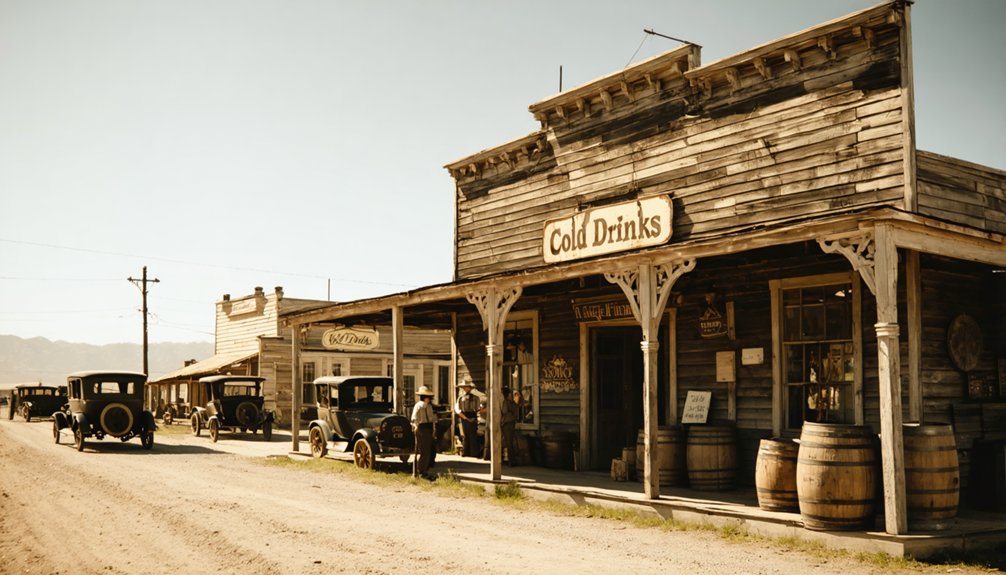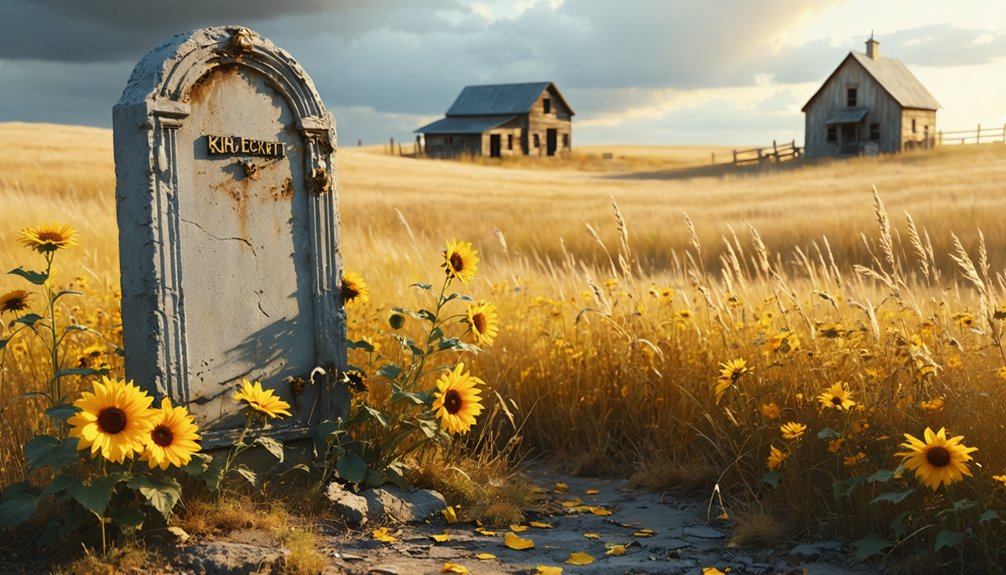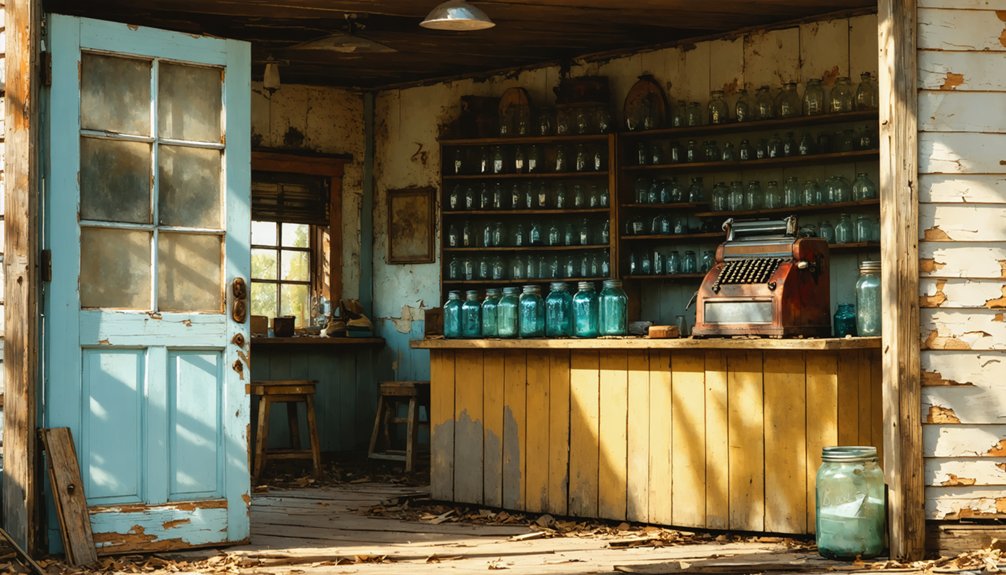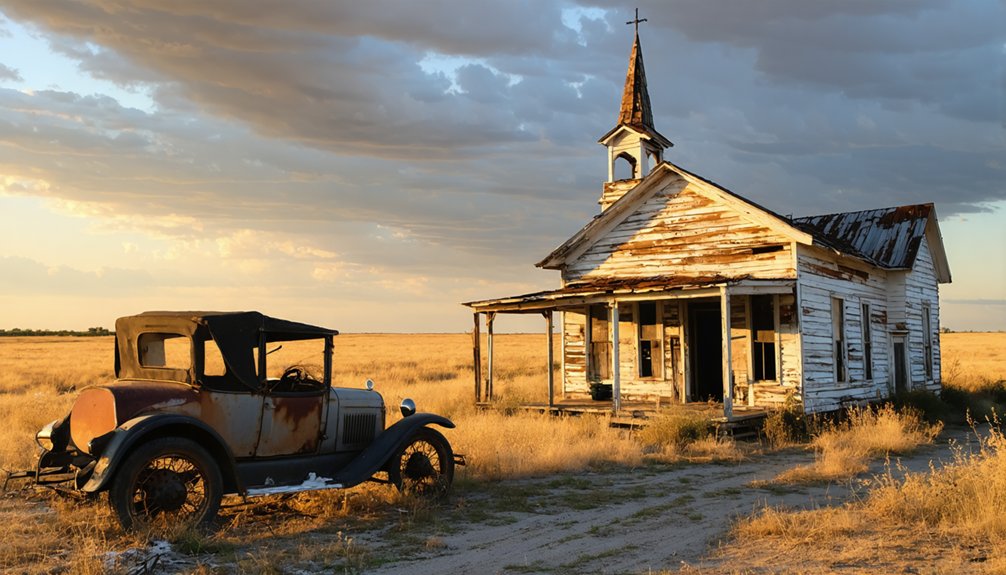You’ll find Eckert’s ghost town remnants in Texas Hill Country, where eight Anglo-American families first settled in 1875. Originally called Nebo, the community renamed itself in 1903 after Wilhelm Eckert opened the first store and post office. While the population peaked at 100 residents in 1925, the Great Depression triggered its decline to just 7 residents by 1964. Today, weathered structures near FM 1323 and State Highway 16 tell a compelling story of pioneer life.
Key Takeaways
- Eckert was established in 1875 as Nebo, reached its peak population of 100 residents in 1925, and declined to ghost town status by 1964.
- The town centered around Mount Zion log church and Wilhelm Eckert’s general store, which opened in 1903 with a post office.
- Located in Texas Hill Country at 1,739 feet elevation, the ghost town features limestone terrain and remnants of historic structures.
- The Great Depression triggered the community’s decline, reducing population from 100 to just 15 residents by 1933.
- Historical remnants include weathered foundations near FM 1323 and State Highway 16, with the cemetery maintained by the Eckert Cemetery Association.
The Birth of a Hill Country Settlement
When eight Anglo-American families established a settlement in the Texas Hill Country in 1875, they laid the foundation for what would become the town of Eckert.
These pioneers built Mount Zion, a log church that quickly became the heart of their growing community. You’ll find this settlement was initially known as Nebo, named after Mount Nebo located three miles north.
The settlement patterns of these early residents reflected the broader expansion of Anglo-European settlement throughout the Texas Hill Country after the 1850s. The town’s name required clear disambiguation from other locations named Eckert across the country.
The wave of Anglo-European migration into the Texas Hill Country shaped the region’s cultural landscape throughout the latter half of the 1800s.
As they carved out their existence through farming and ranching, community dynamics centered around their shared religious and social gatherings at Mount Zion.
Like many Hill Country settlements of the era, they built their lives around the region’s distinctive limestone hills and clear streams. Today, the area remains unincorporated and is governed through Gillespie County.
From Mount Zion to Eckert: A Name’s Evolution
Though the settlement began as Nebo and centered around Mount Zion church, its identity transformed in 1903 with the establishment of a post office by Wilhelm Rudolph Eckert.
The name significance of these early biblical references reflected the deep religious heritage of the eight founding Anglo-American families, who built their community around Protestant values and gatherings at Mount Zion.
The shift to Eckert marked more than just a postal designation – it represented the evolution from a purely religious settlement to a more civic-minded town.
This cultural heritage remained even as the population fluctuated, peaking at 100 residents in 1925 before declining to just 15 by 1933.
You’ll find this pattern typical of Texas Hill Country settlements, where religious roots gave way to more secular, administrative identities.
Located 11.5 miles northeast of Fredericksburg, the small community maintained its distinct identity despite its proximity to the county seat.
Every dollar donated to preservation efforts helps maintain the stories of communities like Eckert for future generations.
Life in Early Eckert
As eight Anglo-American families settled in Gillespie County in 1875, they established a tight-knit rural community centered around the Mount Zion log church.
Daily routines revolved around farming and ranching activities, with neighbors helping neighbors through the challenges of pioneer life. You’d find cultural traditions deeply rooted in Anglo-American pioneer heritage, with church gatherings serving as the heart of social interaction. Similar to Thurber’s laborers who received once-a-month paychecks, the residents had to carefully manage their resources.
Neighbors banded together in daily farm work, sharing Anglo-American traditions while finding community through their cherished church gatherings.
The community’s spirit thrived through mutual aid and family cooperation, while the church provided both spiritual guidance and a meeting place for important events.
After Wilhelm Rudolph Eckert opened his general store in 1903, you’d see townspeople gathering there to collect mail and exchange news, creating a vibrant social hub that defined small-town Texas life.
Geographic Features and Natural Surroundings
You’ll find Eckert nestled in the characteristic limestone-rich terrain of Texas Hill Country, sitting at an elevation of 1,739 feet among gently rolling hills and rocky outcroppings.
Like many Texas ghost towns that faced decline due to natural disasters, the area’s rugged landscape and remote location contributed to its eventual abandonment.
The landscape near Mount Nebo features mixed woodlands interspersed with open pastures, supporting native juniper, oak, and mesquite trees adapted to the calcareous soils.
While there aren’t any major rivers or lakes within Eckert’s immediate vicinity, the area’s seasonal rainfall patterns sustain the natural grasslands and provide habitat for white-tailed deer and various Hill Country wildlife species.
Hill Country Terrain Features
The rugged Texas Hill Country surrounding Eckert features dramatic limestone hills rising 400-500 feet above the valleys of the Edwards Plateau.
You’ll find yourself in a landscape dominated by flat-topped hills and steep canyons, particularly in the Balcones Canyonlands area where the terrain diversity is striking.
The region’s karst topography creates a complex network of caves and sinkholes beneath your feet.
Native plants like yucca and prickly pear thrive in this harsh environment.
As you explore, you’ll notice the thin, rocky soil and exposed limestone that characterizes the hill country.
Original oak forests and prairies created open woodlands that once dominated the natural landscape.
The Balcones Escarpment drops about 700 feet along its fault line, creating distinct changes in elevation from under 1,000 feet in the southeast to over 2,500 feet in the northern portions.
This remarkable terrain makes the area prone to flash flooding during heavy rains.
Water Sources and Springs
Natural springs fed by the Edwards-Trinity Plateau Aquifer system emerge throughout Eckert’s surrounding landscape, providing essential water resources both historically and today.
You’ll find these artesian springs flowing naturally from confined aquifers, forcing pristine water to the surface without mechanical pumping. Similar to the historic Frankston Artesian Well, local residents have traditionally gathered spring water in large containers for household use. Water conservation efforts have become significant as spring flow rates fluctuate with groundwater levels and drought cycles.
These important water features have shaped the region in several ways:
- Supporting diverse spring ecosystems with unique aquatic and riparian habitats
- Delivering reliable drinking water for early settlers and current residents
- Enabling agricultural irrigation through natural pressure systems
- Creating mineral-rich springs that attracted visitors seeking therapeutic waters in the early 1900s
Regional spring flow varies seasonally, making sustainable management essential for preserving these precious water resources. The springs serve as vital community gathering points, connecting local residents with nature while supporting tourism and recreational activities.
The Peak Years: 1920s Community Life

During the peak years of the 1920s, Eckert’s social fabric centered around three essential community hubs: Mount Zion log church, Wilhelm Eckert’s general store, and the local post office.
With a population of nearly 100 residents, you’d find community gatherings happening regularly at Mount Zion, where families would meet for worship and socializing.
The general store wasn’t just a place to pick up supplies – it served as the heart of daily social dynamics, where you’d catch up on local news and engage with neighbors.
Though not always peaceful, as evidenced by a notable cotton-related dispute, these interactions reflected the close-knit nature of rural Texas life.
The primarily Anglo-American population maintained strong social bonds through shared agricultural work, mutual aid, and regular community events.
Economic Rise and Fall
Originally established as Nebo in 1875, Eckert’s economic story began with eight pioneering Anglo-American families who built their livelihoods around small-scale farming and local commerce.
The town’s economic resilience peaked in the 1920s when nearly 100 residents called it home, but the lack of agricultural innovation and economic diversity would soon spell trouble.
You can trace the town’s dramatic decline through these key economic shifts:
- Wilhelm Eckert’s general store and post office initially sparked commercial growth
- The Great Depression triggered the first major population exodus
- By 1933, only 15 residents remained as businesses shuttered
- The population dwindled to just 7 by 1964, marking near-total economic collapse
Without diversification beyond farming and basic retail, Eckert couldn’t sustain itself through changing market conditions.
Notable Residents and Their Legacy

The pioneering spirit of Wilhelm Rudolph Eckert stands at the forefront of this Texas community’s legacy. As both merchant and postmaster, he transformed the settlement’s identity when he opened the first store in 1903, prompting the town’s name change from Nebo to Eckert.
You’ll find the town’s foundations were laid by eight pioneering families who settled here in 1875. These early settlers established the Mount Zion log church, creating the community’s first spiritual and social center.
Community leaders like George W. Graves influenced local development through their decisions, including Graves’ choice to decline the postmaster position. Local farmers and merchants shaped the town’s character, contributing to its peak population of 100 residents in 1925, though their dreams of lasting prosperity eventually faded into ghost town status.
Traces of Yesterday: Remaining Structures
Standing as silent witnesses to Eckert’s bygone era, weathered structures dot the landscape near FM 1323 and State Highway 16.
These abandoned architecture remnants tell the story of a once-thriving community that peaked at 100 residents in 1925.
Time-worn ruins whisper tales of Eckert’s glory days, when a hundred souls called this Texas crossroads home.
You’ll find historical remnants scattered throughout the site, including possible ruins of Wilhelm Rudolph Eckert’s store and post office.
While exploring these forgotten places, you’ll encounter:
- Weathered foundations and crumbling masonry where commercial buildings once stood
- Skeletal remains of early-20th-century residential structures
- Rusting hardware and faded signage from former businesses
- Possible remnants of the Mount Zion log church
The structures remain accessible from nearby roads, though you’ll need to respect private property boundaries and exercise caution around unstable ruins.
Preserving Eckert’s Historical Memory

While no formal government structure exists to preserve Eckert’s history, you’ll find dedicated community groups and historical societies working to document the town’s heritage through various initiatives.
You can explore the town’s legacy through the Texas Ghost Town Newspaper Collection and digitized archives at the University of North Texas Libraries, which contain rare firsthand accounts of life in early Eckert.
The Eckert Cemetery Association maintains the town’s burial grounds, providing a tangible connection to the past and serving as an essential resource for genealogical research and historical tours.
Community Documentation Efforts
Dedicated preservationists in East Texas have mounted extensive efforts to document Eckert’s history through a coordinated network of local historical societies and volunteer organizations.
Their community engagement initiatives focus on gathering essential historical documentation, including maps, photographs, and written records that tell the story of this vanished town.
You’ll find extensive archival work being conducted through:
- Collection of oral histories from descendants of original settlers
- Digital preservation of cemetery records and property documents
- Partnerships with regional libraries and museums for centralized access
- Documentation of existing architectural features and artifacts
These efforts guarantee that Eckert’s legacy won’t be lost to time.
Through collaboration with state historic commissions and local officials, preservationists are creating a thorough record that future generations can access to understand this piece of Texas history.
Sites Worth Remembering
Modern-day visitors to Eckert can explore several significant historical sites that paint a vivid picture of this once-thriving Texas community.
You’ll find the Mount Zion log church site from 1875, a representation of the original Nebo settlement’s spiritual center. The junction of State Highway 16 and FM 1323 marks where Wilhelm Rudolph Eckert’s influential general store once stood, while historical markers guide you through the town’s evolution.
For ghost town tourism enthusiasts, the well-maintained Eckert Cemetery offers insights into local heritage, and the surrounding Hill Country terrain showcases why settlers chose this location.
You can trace the remnants of historic trails near Mount Nebo, where natural landmarks and deteriorating foundations tell the story of this vanished community’s past.
Frequently Asked Questions
Are There Any Paranormal or Ghost Stories Associated With Eckert?
You won’t find documented haunted tales or local legends from Eckert. Unlike many Texas ghost towns, there’s no verified paranormal activity, and historical records don’t mention any supernatural occurrences in the area.
Can Visitors Legally Explore the Remaining Structures in Eckert Today?
While you might feel drawn to explore freely, you can’t legally access Eckert’s structures without permission since they’re on private property. You’ll need to contact landowners for legal access rights.
What Wildlife Species Are Commonly Found in the Abandoned Town?
You’ll find diverse wildlife sightings including eastern fox squirrels, mule deer, bats roosting in ruins, various raptors, upland game birds, lizards, and snakes adapting to the abandoned structures and surrounding habitat.
Did Any Famous Outlaws or Historical Figures Pass Through Eckert?
You won’t find any documented evidence of famous outlaws or historical travelers passing through Eckert – historical records show it remained a quiet farming settlement without notable visits.
Were There Any Significant Archaeological Findings in the Eckert Area?
Like a dusty book with blank pages, you won’t find significant archaeological findings here. While nearby regions boast prehistoric sites and historical artifacts, there’s no documented archaeological significance specific to Eckert’s area.
References
- https://www.wikiwand.com/en/articles/Eckert
- https://mix941kmxj.com/the-strange-sad-story-of-a-texas-ghost-town-youll-never-visit/
- https://en.wikipedia.org/wiki/List_of_ghost_towns_in_Texas
- https://www.hillcountryportal.com/eckert.html
- https://www.tshaonline.org/handbook/entries/eckert-tx
- https://www.lonestartreasure.com/texas-ghost-towns-and-their-buried-riches/
- https://www.texasescapes.com/TexasHillCountryTowns/Eckert-Texas.htm
- https://www.texasescapes.com/TOWNS/Texas-Ghost-Towns-3-Hill-Country.htm
- https://kicks105.com/ghost-town-strange-name/
- https://en.wikipedia.org/wiki/Eckert



